Get Comfortable with the Terms.
You have probably already heard the mantra of the Four C’s - Cut, Clarity, Color, Carat, but here’ s a quick primer for the new initiate:
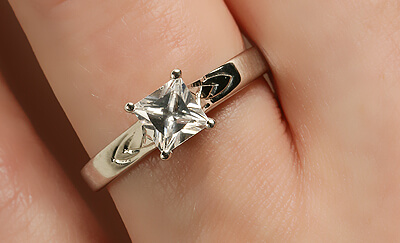
Learn about the four C's to better understand the quality & value of your Celtic engagement ring.
Cut: The accuracy and style of cut is what determines a diamond’s brilliance. The better the cut, the more the gem sparkles. Cuts range from Fair, Good, Very Good and Ideal to Signature Ideal. Most consumers choose a cut in the Very Good to Ideal range.
Clarity: Clarity refers to the imperfections present in the diamond. All diamonds have naturally occurring imperfections, but some are not visible to the naked eye, and thus have no bearing on the stone’s beauty. Grades are from I1 (minor inclusions visible to the naked eye) to IF (No internal imperfections). Most people choose a diamond in the VS2 to SI1 range.
Color: Color refers to the diamond’s lack of color, with the most white diamond being the most favored. Color grades range from Z (lowest, or most yellow) to D (highest, or most white). Most people prefer a stone in the G to H range if possible.
Carat: Carat refers to the diamond’s weight. A carat is based on points, with there being 100 points in a 1-carat stone. The most popular size is the 1-carat stone.
Heavy Metals.
The earliest wedding rings were thick gold bands, sometimes with incised designs. The Celts used jewelry knots, an ornamental design that featured complete loops with no end or beginning to signify the lasting relationship, and often worked these patterns on gold, silver, bronze or copper rings. It wasn’t until the late 1500s that the design focus began to include gemstones.
Today’s wedding and engagement rings don’t have to be gold -- they can be white gold, silver, rose gold, copper, platinum and even stainless steel.
Although today’s metals are varied and abundant, two of the most popular choices remain gold and platinum. While gold has a timeless elegance and can be continually returned to its just-forged brilliance with careful buffing, it is a soft metal and stones often require re-shanking every so often to keep the them secure.
Platinum, on the other hand, is an extremely durable metal and makes a wonderful counterpoint to the sparkle of a diamond. It does have a drawback in that it is usually quite difficult to return it to its initial brilliance after the finish has worn a bit, although most people find its soft patina quite appealing and think it a fair trade for durability.
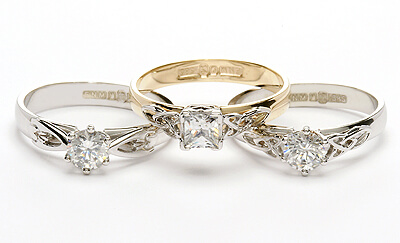
Traditional yellow gold or modern white gold? Which gold type do you prefer?
Metal rings with design work are very popular with today’s engagement ring buyers, particularly Celtic designs with ornate knots and scrolls. These are particularly appropriate for couples considering and Irish, Celtic, or Renaissance-themed wedding.
The Setting.
There are countless numbers of setting designs available to today’s prospective groom. The most common are prong, bar, tension, bezel, channel, flush, cluster and invisible. A Prong setting is your typical ring setting, where the stone is gripped in 3, 4 or 6 prongs. A Bar setting holds diamonds in place by tiny metal bars perpendicular to the ring band for a contemporary look. The Tension setting is spring-loaded to put pressure onto the gemstone, and tiny grooves are added to the metal in order to create a shelf for the edges to rest so the stone appears to be suspended in the air with nothing holding it in place.
The Bezel setting is a lovely, medieval looking setting where the gem is encircled with a band of metal that completely envelopes the diamond’s edges. It is very protective of the gemstone and can make a smaller stone look much larger. The Channel setting features a series of small diamonds set in a channel of metal. The Flush setting is also known as the Gypsy setting, where the diamond is held into a tapered hole that is drilled into the band. It is highly protective of the stone. The Invisible setting was made famous by Cartier and Van Cleef & Arpels. The stones (usually square for a tighter fit) are set next to each other without any visible metal holding them in place.
Although it might seem tempting to reach for some of the more uncommon varieties, keep in mind that the simple prong setting maximizes the sparkle of the diamond by allowing the most light to travel through the stone. However, if your fiancee has an active lifestyle, it might be in your best interest to choose a design that offers less opportunity for the jewelry to snag clothing or catch on equipment by choosing channel, flush or invisible designs. Don’t forget that most jewelers can offer a bespoke design for those who just can’t seem to find what they are looking for.
A Variety of Shapes.
There are a variety of shapes that diamonds and other gemstones can be fashioned into. The Brilliant, or Round, diamond is one of the most popular because it has the greatest number of facets to reflect the most light and create the most sparkle in the stone. A more contemporary look with an ample amount of flash can be had in the Princess cut, an elegant square shape with pointed corners. An Emerald cut, which is simple and clean-looking, highlights a diamond’s elegance more than its sparkle, but is a good choice for a bride who loves classical beauty.
The Marquise cut has a slender, diamond-shaped silhouette that makes a smaller diamond appear larger, which is a plus for extending your ring budget. Pear-shaped stones combine the brilliance of a Round shape with the sharp edges and classic look of a Marquise. A Pillow, or Cushion-cut, had rounded corners and larger facets and is relatively hard to find. The Asscher cut has the look of an Emerald-cut diamond with a square shape, and the Radiant cut combines the geometry of an Emerald with the brilliance of a Round. Finally, the Heart shape appeals to hopeless romantics everywhere and is particularly suited to colored diamonds.
But What About Budget?
You can get a wonderful ring on a budget! Here are some little-known facts that will maximize your budget and still allow you to purchase a heart-stopping beautiful ring.
First, consider a nontraditional setting or shape. Some shapes, such as the Square, are less expensive to purchase and are often very eye-catching for their rarity.
Also, since very few people can tell the difference between a 0.9-carat stone and a 1-carat stone, go with the smaller stone -- it can save you up to 30%! Getting a stone just 1 or 2 tenths smaller that the standard sizes (1-carat, 1.5-carat, 2-carat and so on) can allow you to get the ring she’ll love without sacrificing quality.
Consider nontraditional stones for real savings. Sapphires and rubies are becoming popular in engagement and wedding rings since they are quite hard. Gemstone hardness is important in a ring that will be worn daily, so it definitely should be a consideration. Remember that rubies come in all shades of red and pink, but sapphires come in shades from clear, through a spectrum of blues, through pink, green and even yellow.
One of the best ways to conserve cost is to purchase your ring online. According to The Wedding Report, in 2010 more than $1 billion were spent on wedding and engagement rings online. Why the rush to online buying? Two reasons, really. First of all, an online retailer has more competition than a retail location and so must keep prices low to maintain a competitive edge. Second, by foregoing an actual brick-and-mortar location with all its attendant costs and taxes, the online retailer is often able to pass along cost savings to the consumer.
Be the Lord of the Ring.
Whew! You’ve done you’re research and are ready to make your purchase. Although many couples choose to shop for this all-important purchase themselves, there is a certain wow factor implicit in presenting her with the ring of her dreams that you shopped for on your own. Now enjoy our extensive range of Celtic engagement rings with a trained eye.

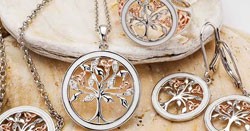
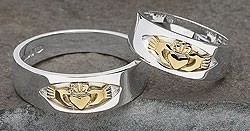
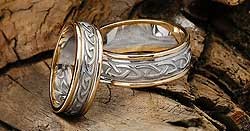
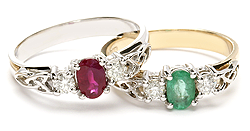
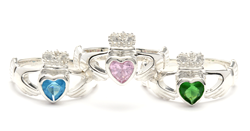
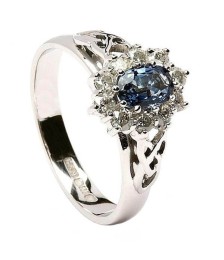 Sapphire Diamond Cluster Ring
Sapphire Diamond Cluster Ring 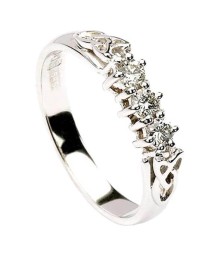 Trinity 3 Stone Ring
Trinity 3 Stone Ring 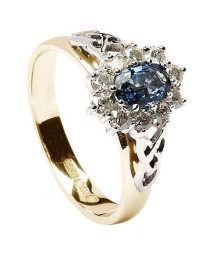 Sapphire & Diamond Ring
Sapphire & Diamond Ring 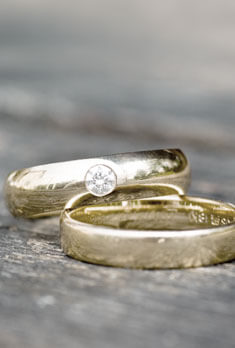

 Celtic Knot Wedding Ring
Celtic Knot Wedding Ring  Celtic Knot Ring with Trim
Celtic Knot Ring with Trim 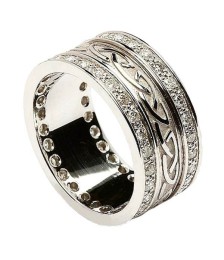 Embossed Celtic Ring with Trim
Embossed Celtic Ring with Trim 